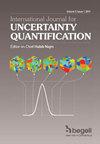基于衍生的夏普利值,用于全局敏感性分析和机器学习的可解释性
IF 1.8
4区 工程技术
Q2 ENGINEERING, MULTIDISCIPLINARY
International Journal for Uncertainty Quantification
Pub Date : 2024-05-01
DOI:10.1615/int.j.uncertaintyquantification.2024051548
引用次数: 0
摘要
我们为全局敏感性分析和机器学习可解释性引入了一种新的夏普利值方法。该方法基于基础函数的一阶偏导数。该方法的计算复杂度与维度(特征数量)呈线性关系,而文献中其他夏普利值方法的计算复杂度呈指数关系。全局灵敏度分析和机器学习中的实例将用于对该方法与活动评分、SHAP 和 KernelSHAP 进行数值比较。本文章由计算机程序翻译,如有差异,请以英文原文为准。
Derivative-based Shapley value for global sensitivity analysis and machine learning explainability
We introduce a new Shapley value approach for global sensitivity analysis and machine learning explainability. The method is based on the first-order partial derivatives of the underlying function. The computational complexity of the method is linear in dimension (number of features), as opposed to the exponential complexity of other Shapley value approaches in the literature. Examples from global sensitivity analysis and machine learning are used to compare the method numerically with activity scores, SHAP, and KernelSHAP.
求助全文
通过发布文献求助,成功后即可免费获取论文全文。
去求助
来源期刊

International Journal for Uncertainty Quantification
ENGINEERING, MULTIDISCIPLINARY-MATHEMATICS, INTERDISCIPLINARY APPLICATIONS
CiteScore
3.60
自引率
5.90%
发文量
28
期刊介绍:
The International Journal for Uncertainty Quantification disseminates information of permanent interest in the areas of analysis, modeling, design and control of complex systems in the presence of uncertainty. The journal seeks to emphasize methods that cross stochastic analysis, statistical modeling and scientific computing. Systems of interest are governed by differential equations possibly with multiscale features. Topics of particular interest include representation of uncertainty, propagation of uncertainty across scales, resolving the curse of dimensionality, long-time integration for stochastic PDEs, data-driven approaches for constructing stochastic models, validation, verification and uncertainty quantification for predictive computational science, and visualization of uncertainty in high-dimensional spaces. Bayesian computation and machine learning techniques are also of interest for example in the context of stochastic multiscale systems, for model selection/classification, and decision making. Reports addressing the dynamic coupling of modern experiments and modeling approaches towards predictive science are particularly encouraged. Applications of uncertainty quantification in all areas of physical and biological sciences are appropriate.
 求助内容:
求助内容: 应助结果提醒方式:
应助结果提醒方式:


